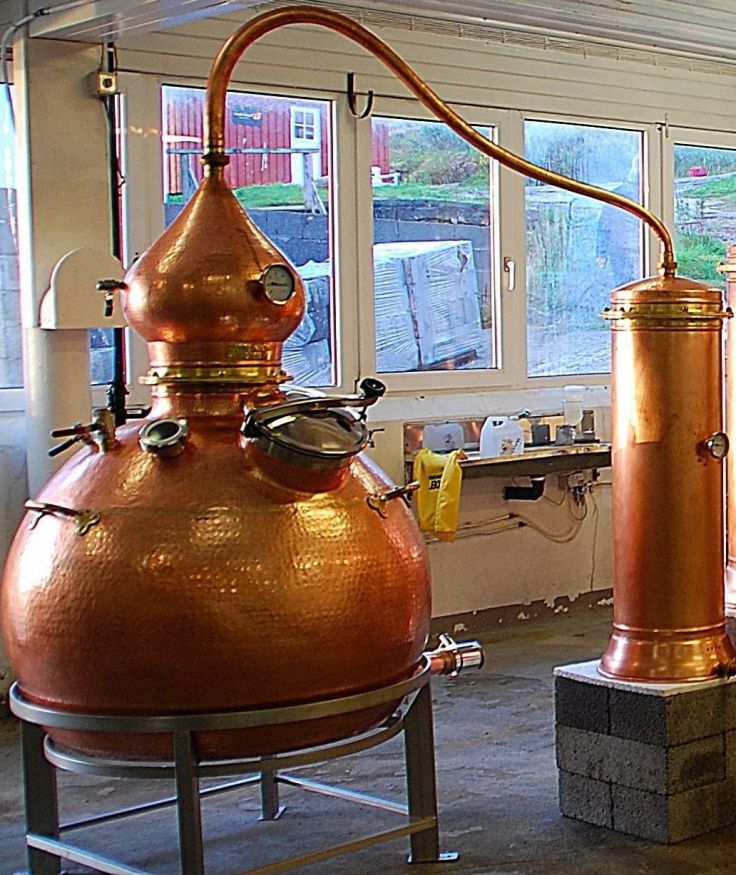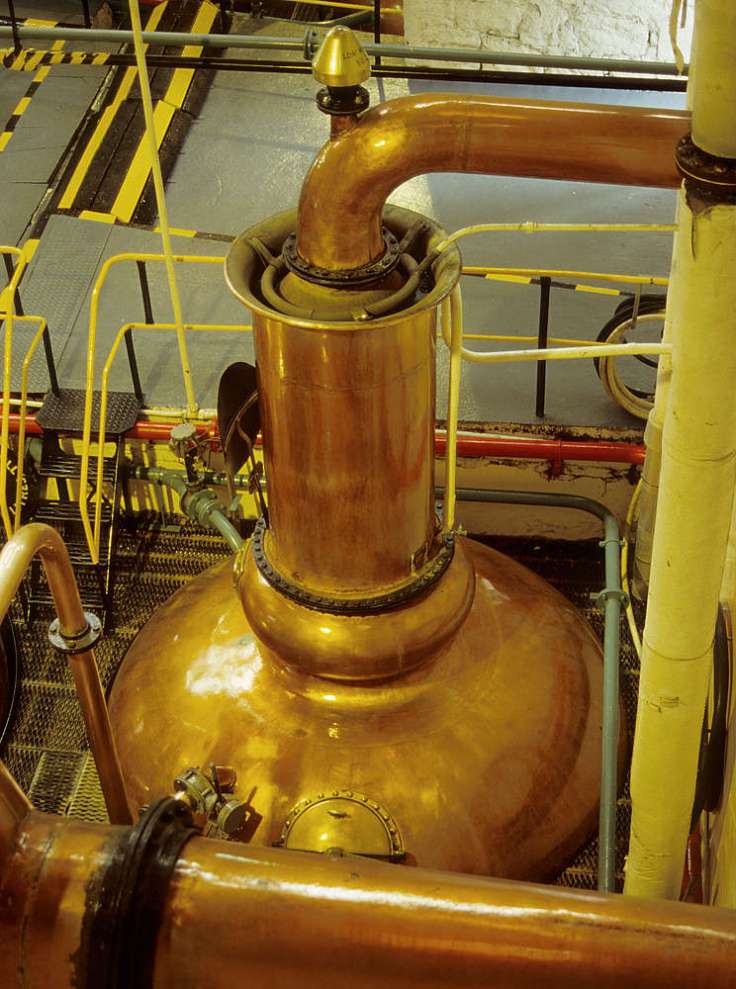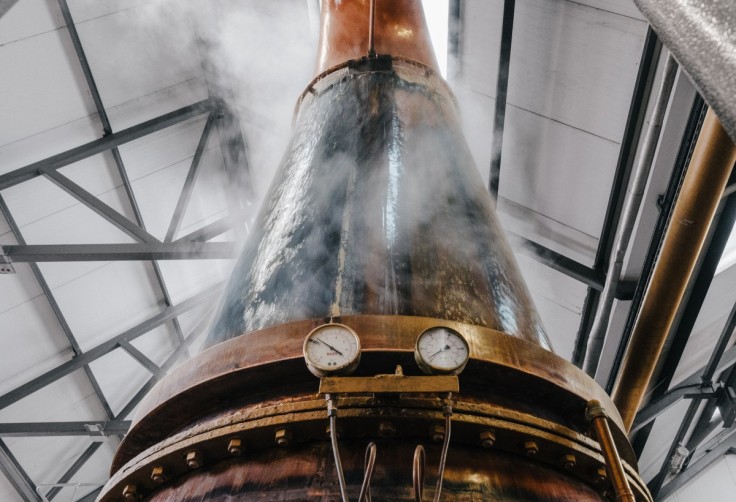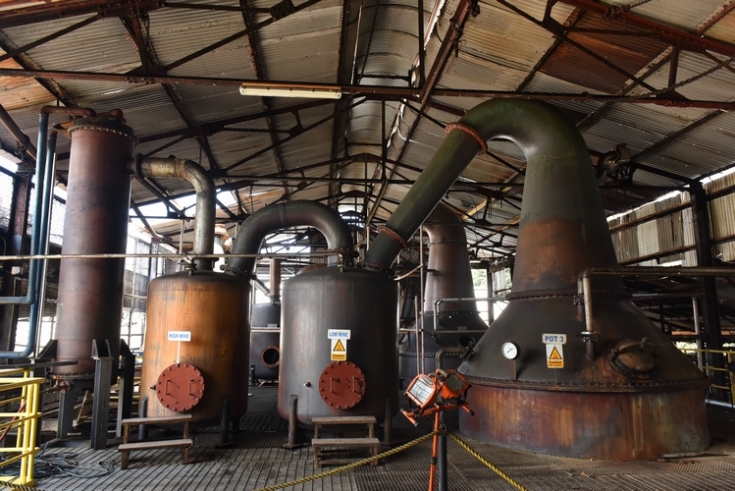A love letter to Pot Still Distillation

Simple Alembic
The humble pot still has existed in some form since the advent of distilling. Starting with the simple alquatar and moving forward to complex hybrid systems complete with gin baskets, columns, bubble plates, jacketed cooling systems and more. The pot still, although not widely understood by the general public, nor even by a lot of modern column still distillery “operators” is probably the single most recognizable symbol of distilling in the eye of the general public and has been incorporated by many distilling companies or spirits related companies due to this recognition.

Pot with rectification lenses
Although the pot still is one of the oldest forms of distilling equipment it’s place in the modern distilling industry, despite myriad technical advances, is very secure and for most of the world pot distilled spirits are the mark of quality and craftsmanship. Pot stills are widely recognized by producers and imbibers because of their built-in inefficiencies which when well executed can produce superior products which require the trained senses of an experienced distiller in the process of distillation.
If one thinks of the humble moonshiner, they think of the pot still. If one thinks of Single Malt Scotch they think of the pot still, if one thinks of Cognac they think of the pot still, and if one delves into the history of any potable spirit with the exception of high proof ethanol the pot still will have no doubt have shaped the history and the taste profile of each of those spirits. Yes doubters, this includes Bourbon and Rye.
 Fettercairn water Cascade for forced reflux
Fettercairn water Cascade for forced reflux
It isn’t my intent in this short introduction to get into technicalities but instead to confess my love of pot stills and all their eccentricates. Here I will focus on all those things that for me make pot stills special in a way that no other system could ever be.
 Lomond still. Similar to a modern hybrid or old fashioned Saville still with three plates all independently cooled and capable of tilting.
Lomond still. Similar to a modern hybrid or old fashioned Saville still with three plates all independently cooled and capable of tilting.
Pot Stills at their core are most simply about the retention and concentration of flavor and more importantly aroma derived from the raw material of fermentation. Pot stills in their most basic form are agricultural and traditional cultural tools and the distilling carried out on such systems is reflective of the regional agriculture and cultural culinary norms of the community within which they are operated. The operation of pot stills is always agricultural in nature, even when industry is involved. From the earliest time the pot still was looked at and understood to be yet another farm implement, albeit an important one capable of transmuting raw beer (for whiskey) or wine (for brandy) or botanicals (absinthe, gin, aquavit) into a more portable and value added product that in itself offered psychoactive relaxation and the opportunity to experience the aroma of a time and place at a later time and place often removed by the cold weather seasons or by miles traveled. Pot stills are Alchemy, pot stills are sexy.
 Double retort rum still.
Double retort rum still.
Pot stills are batch systems meaning that their industrialization and therefore bastardization is limited. A pot still can never handle anymore beer or wine than the capacity the boiler (or pot) has to hold or than what time has provided to distill correctly. Over the centuries many have tried to “hack” the pot still system in order to speed up the process and in every case the system failed. Often these trends focused on using shallow stills that could rapidly distill and be refilled from pre-heaters and generally the patents for these apparatus were and their invention was spurned on by the ignorance of government tax collectors who themselves wanted to gather the maximum amount of profit possible with little to no effort on their own behalf. Where I’m from we call this Carpetbagging. In every instance the “Improvements” would fail to meet the quality expected by the drinking public and in every instance the one who truly profited was either the legal distiller who stuck with the tried and true principals of the pot still or the illicit distiller who could not be pressured to give up his or her trade and dedication to the old ways handed down from generation to generation.
 Tennessee Thumper Still Rev. Thomas Green model with bypass and two independent vapor paths containing four retorts each.
Tennessee Thumper Still Rev. Thomas Green model with bypass and two independent vapor paths containing four retorts each.
Pot stills are reflective and percussive instruments. The operation thereof is a simple mimicry of natures processes of evaporation and condensation as well as other atmospheric conditions and subsequently many variables can affect the distillation process in these systems. All manner of variables has profound effects on simple pot still distillation. Barometric pressure changes from storm fronts and high-pressure fronts can slow distillation the same as turning down the fuel used to heat the system. Because the “head” of the still heats slower and cools quicker than the pot more reflux is created during cold weather or in cool environments than in hot weather or warm environments. This reflux raises proof and purity and drops out heavier and more aromatic and flavorful components meaning that a pot still subsequently makes a lighter style in cool weather than in warm weather. The set-up of the lyne arm itself and the subsequent angle of the vapor leaving the still for the condenser can create vast differences in natural reflux as well. The very mood of the distiller as well as physical or spiritual ailments can affect pot stills as well. A true pot still is always operated by a true distiller using their senses to determine what fractions of alcohol and wherein the distillation of that alcohol that “cuts” or the removal of unwanted components (Fores, Heads, Hearts, Tails) are made. If a distiller walks into work in a great mood and with plenty of sleep as well as a palate clean of heavy foods he or she will make an entirely different cut to the product than a distiller who comes to work in a bad mood, little sleep, and having made poor dietary choices for the job at hand (spicy foods, smoking, etc.). The distiller will use every sense that they have to make those cuts. Every system has a sound, every fraction of alcohol a distinct aroma, taste, and feel (dry, oily), and the simple observation by sight of the speed of distillation or the quick read of a hydrometer even inaccurate will tell the tale (or tails!).
Moon phases greatly effect distillation on pot still systems. Just as the moon has a pronounced effect in the atmosphere of the earth such as high tide and low tide or the high turnout of medical emergencies during full moons so too does the moon have an effect on the liquid and vapor contained in the enclosed system. Full Moons produce quicker distillations with all variables otherwise remaining the same than do new moons. So called “super” moons have their effects as well.
Pot stills are individuals. Each has its own set of quirks. Even stills made by the same manufacturer, of the same design, and run by the same parameters turn out different distillates from one another. You could have five stills produced by the same builder to the same specifications, run in the same building, run by the same distiller, and running the same product and each of those five stills will produce a slightly different flavor profile. Pot still distillation is a LIVING and DYNAMIC art that can not be mimicked by other systems. By the variables above you can see that consistency is not created by pot stills, it is instead managed over time by the distiller or blender testing their stocks and making blends that fit a “profile” for a product. In fact, we want variation, we pot still distillers love the ability to create unique one-off products and see the diversity of a single grain bill or varietal with far more variation than the simple placement of a barrel in different locations during ageing to create individual expressions.
Due to the stated individuality of the pot still and because of old school superstition every pot still should have a name. The still should be run a time or two and evaluated by the distiller for the unique properties it presents and named appropriately thereafter. Myself, I tend to name my pots after goddesses of antiquity or Biblical characters, but always, always, of the feminine persuasion, pot stills do after all have curves, dints and dings, but also present perfection just like the feminine form.
Although the batch size and industrial efficiency of the pot still is limited the production of a myriad of diverse spirits is not at all limited by a well-designed pot still and the many options that can be added to them. Simple cooling coils or jackets on the head or line arm or the placement of a dephlegmator can allow for the production of amazing, light bodied and subtle spirits or the elimination of unwanted congeners. The implementation of a bubble plate column can raise proof and purity for the production of single pass style spirits or high proof spirits. The addition of multiple vapor paths can allow for the implementation of “gin baskets” holding botanicals of great quality and can create spirits unlike any that ever existed before. Simple “retorts” or thump barrels can allow for the raising of proof and purity, the addition of unique and beautiful flavor compounds, the building of unique acids for esterification, and so much more. To boot these many additions and the flavorful spirits that they create can be blended in many proportions to create an entirely different style of spirit. Heavy bodied whiskies or brandies can also be used to make unique botanical creations and develop flavor bridges between otherwise unrelated components. The sky is not the limit, there is no limit, and despite our heritage of pot still distillation we are nowhere near the apex of the possibilities!
The old-fashioned pot still is in fact still the best option for true artists, true farmers, true lovers of an ancient by not outmoded heritage.

